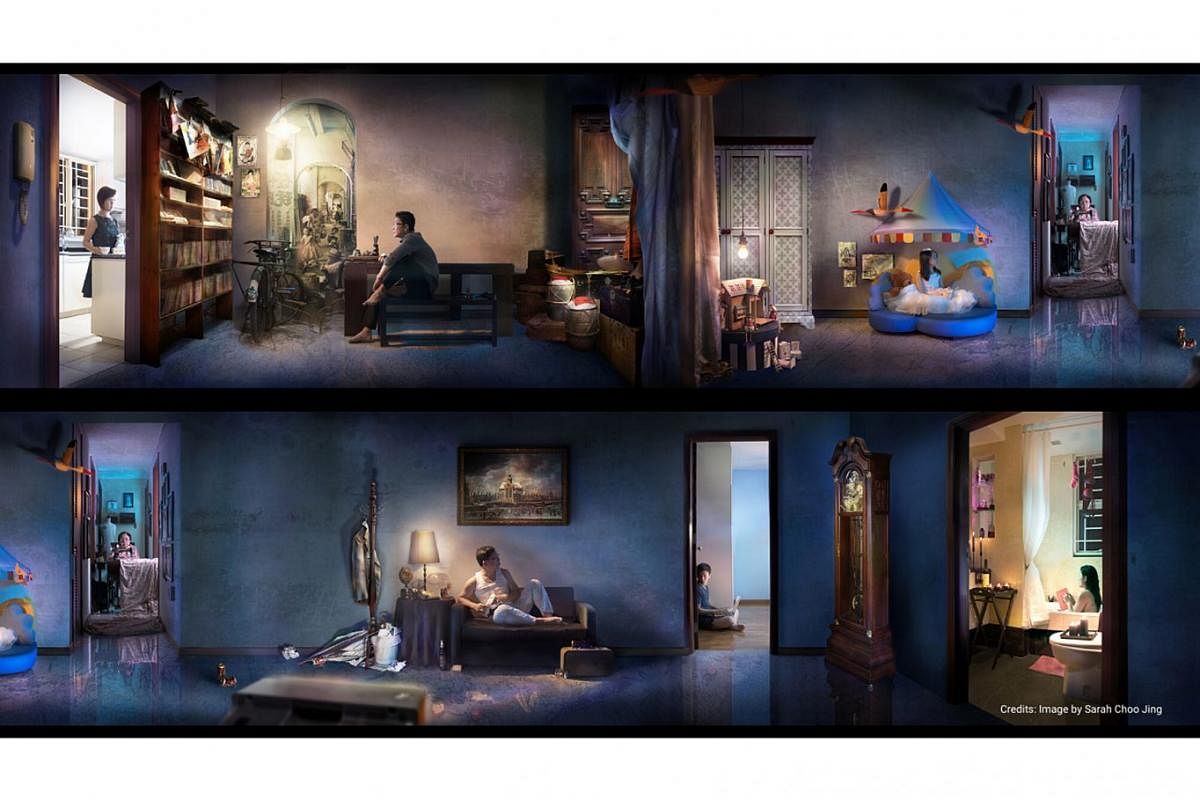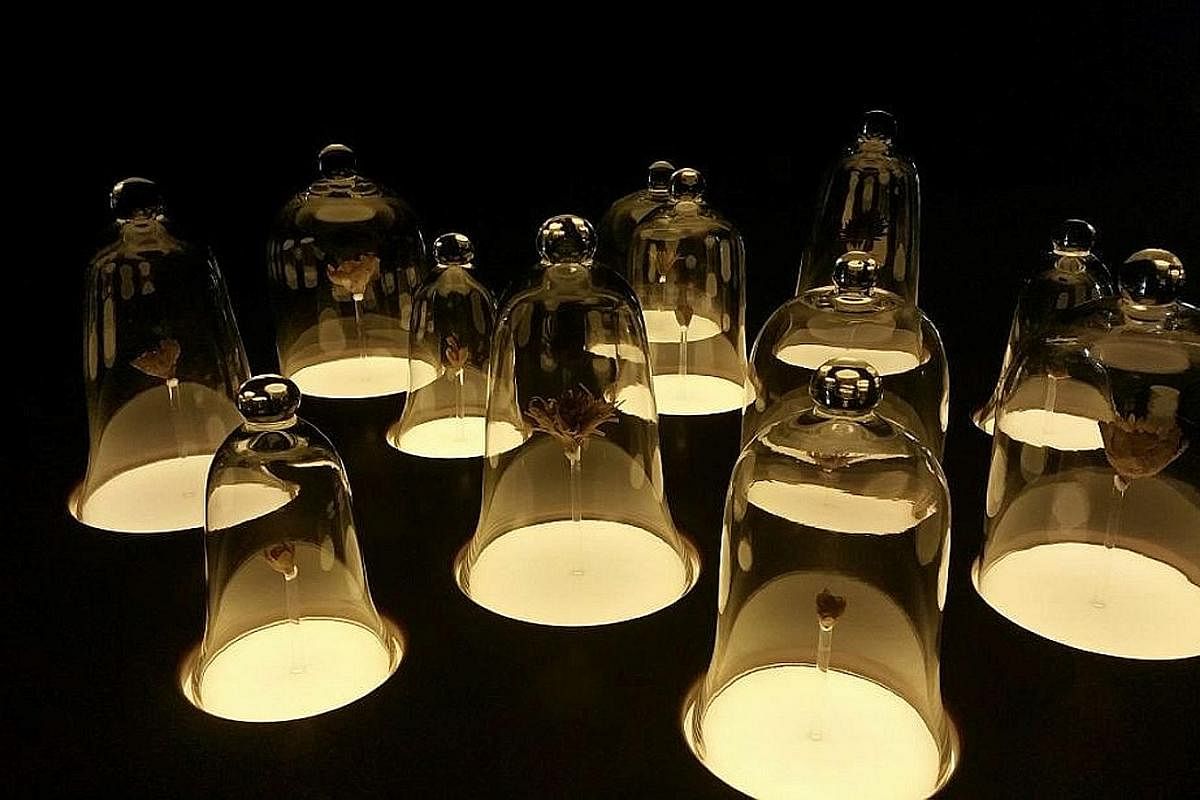-
VIEW IT / SLOW ART PROGRAMME
-
WHERE: Zoom
WHEN: Thursday, 8pm; Aug 27, 8am
ADMISSION: Free by registration at www.nationalgallery.sg
ART + LIVE: RESONATES WITH FEATURING LYNNETTE SEAH
WHERE: www.facebook.com/nationalgallerysg
WHEN: Aug 29, 2.30pm
ADMISSION: Free
Go slow, let art relax you
As the Covid-19 pandemic drags on, some local museums have taken to angling their programmes around self-care and mindfulness



"Let go of everything around you and focus on this artwork."
This is the refrain that runs through the National Gallery Singapore's Slow Art programme, which applies the principles of mindfulness to art appreciation.
This is no snap and dash - here, you can stare at a single work of art for half an hour.
Over video-conferencing platform Zoom, docent Sylvia Peh, 56, walks attendees through studying a painting - Malaysian artist Chia Yu Chian's blue-toned hospital scene The Treatment (1980), based on the artist's frequent hospitalisations, though this context is not revealed until much later - and guides them through a series of exercises.
Think of a song to listen to while looking at this painting. Choose a character in the painting and sketch him or her from memory. If you could ask someone in the painting a question, what would it be?
"I would like to ask the boy with the crutches - does he feel lonely?" says a participant. "He's almost separate from the other people in the painting."
As the Covid-19 pandemic drags on, filling lives with uncertainty and isolating people from one another, some local museums have taken to angling their programmes around self-care and mindfulness.
The connection between art and wellness is an old one, says Ms Suenne Megan Tan, National Gallery Singapore director of audience development and engagement. It has, however, emerged as especially vital during Covid-19.
"These programmes allow audiences to feel uplifted during this very challenging period - previously of physical isolation, now of safely distancing in place - such that they can continue to feel connected to a larger community," says Ms Tan, 45.
For a SingHealth art therapy programme for healthcare workers, the National Gallery and Singapore Art Museum developed the Care Collection, a selection of 30 artworks from the National Collection specially curated based on themes such as courage, resilience and hope.
The works range from Ezzam Rahman's Here's who I am, I am what you see (2015), an installation of flowers made from dead skin from the soles of the artist's feet; to Sarah Choo Jing's The Hidden Dimension II (2013), a looped multimedia installation that depicts seven family members going about their daily routines in the various rooms of their house, isolated from one another except for a single moment when they all look up in tandem at one another and the viewer.
Singapore General Hospital (SGH) art therapist Dian Handayani, 42, picks one artwork every week for the participants of the SingHealth iThrive Artpreciate programme to focus on.
The half-hour sessions, held over Zoom weekly, started in June at SGH. There are plans to expand them to all healthcare workers and staff under the SingHealth cluster, including KK Women's and Children's Hospital and polyclinics, and eventually to run them as physical classes in one of the hospitals when social distancing rules allow it.
Ms Dian guides the participants to view, reflect and embody the artwork. "I do so by asking them leading questions, such as, 'How does this artwork make you feel?' or 'Is anything in the picture a symbol of something you can relate to?' The questions I ask are to encourage the participants to let go of their everyday stresses and to focus on being mindfully present in the session," she says.
Ms Tan says: "What Dian essentially does for the healthcare workers is create a mental oasis in the middle of a very frenetic day."
Ms Dian had intended to conduct the sessions with five or six participants to keep them intimate, but has been getting an average of 11 participants a week and is looking to open up to at least 20 people to meet demand.
Ms Jenny Tan, an associate in Sengkang Community Hospital's office of patient experience, says of the session she attended: "It gave me a sense of tranquillity and I came out of it feeling more assured and confident."
The success of the art therapy programme led the National Gallery to develop Slow Art, which is free to the public. Elsewhere, it has also moved its ongoing multi-disciplinary art programme Art + Live, which promotes connection between art and the self, online.
In sessions live-streamed from the gallery's Facebook page, musicians BL Duo have played pieces inspired by Fu Cha, Cao Fei's boat-like installation in the Ng Teng Fong Roof Garden Gallery, while somatic therapist and movement artist Vincent Yong has used Ng Eng Teng's iconic sculpture Mother And Child to guide participants through movement at home.
"Part of that exercise is really to get you in touch with your body," says the National Gallery's Ms Tan of the sessions by Yong.
"I think it's not just a physical connection, but also your mental state, how your state of mind and body needs to be aligned."
The sessions, available on the gallery's Facebook page, can draw a few thousand viewers. In the next instalment on Aug 29, violinist Lynnette Seah will perform music pieces in response to artworks from the Permanent Galleries.
Earlier this month, the National Gallery also launched Words That Count, a website which allows the public to write blackout poems - created by erasing words from a base text - using the letters written by pioneer artist Georgette Chen. They can then dedicate these to healthcare workers.
At the ArtScience Museum, art is sometimes about taking a deep breath. The museum worked with the Singapore Association for Mental Health (SAMH) on Make Your Own: Breathing Visualisation, a virtual programme with a guided breathwork exercise, after which participants translated the rhythm of their breath onto paper as line art.
The workshop, which ran on Aug 7, was based on German artist John Franzen's Each Line One Breath works, in which he lets his breath guide his hand in simple line drawings that accumulate into massive pieces.
SAMH programme executive Isabel Su, 30, says: "The current Covid-19 situation is a stressor for many, causing heightened anxiety and worry. This shows up as tension in the physical body which participants may not even notice when they are not breathing generously."
Translating the rhythm of breathing into paper, she adds, can help participants to focus and presents a tangible visualisation of their breathing process.
Ms Su says: "When this is practised in the long run, it may also be beneficial for mental well-being, blood pressure, heart rate, digestion and deep tissue repair."
Says the National Gallery's Ms Tan: "I think arts and wellness is a segment that's become even more relevant during this time of Covid-19.
"As a gallery, we see ourselves continuing to sustain a level of programming that really looks at the restorative properties and healing powers of art."
• Words That Count is available at www.nationalgallery.sg/wordsthatcount
This article has been edited for clarity.
Join ST's Telegram channel and get the latest breaking news delivered to you.
A version of this article appeared in the print edition of The Straits Times on August 18, 2020, with the headline Go slow, let art relax you. Subscribe











